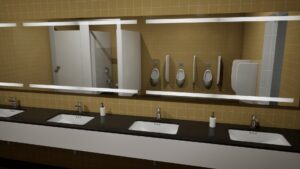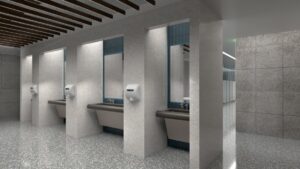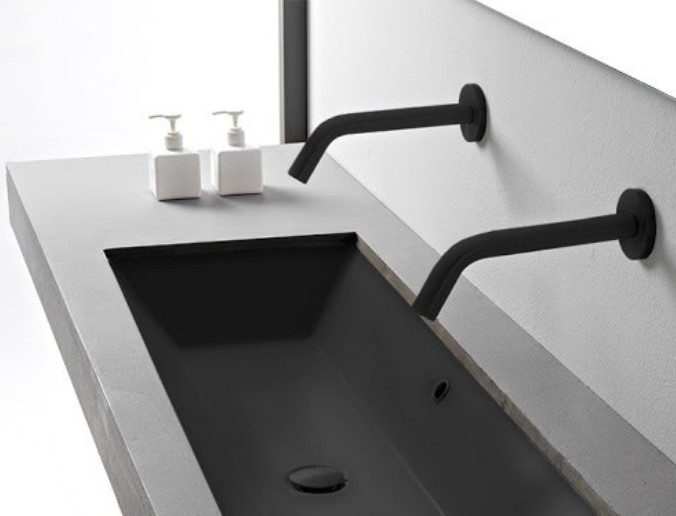
A Case Analysis by Fontana Touchless Faucets
Focus Points
This study investigates the impact of sensor-based bathroom fixtures by Fontana Showers on water usage and hygiene efficiency in public restrooms. Utilizing data from various public facilities, we demonstrate significant reductions in water consumption and improvements in hygiene standards. The findings highlight the importance of modern plumbing technologies in promoting environmental sustainability and public health.
Table of Contents
- Introduction
- Background
- Objectives
- Scope of Study
- Literature Review
- Water Usage in Public Bathrooms
- Hygiene Standards in Public Restrooms
- Technological Innovations by Fontana Showers
- Methodology
- Data Collection
- Survey and Observation
- Statistical Analysis
- Results and Discussion
- Water Usage Analysis
- Hygiene Efficiency
- User Feedback
- Case Studies
- Hospital Case Study
- School Case Study
- Commercial Building Case Study
- Airport Case Study
- Conclusion
- Summary of Findings
- Implications for Public Health and Environment
- Recommendations
- Policy Implications and Future Directions
- References
Introduction
Background
Environmental Issues Related to Water Usage in Public Restrooms
Public restrooms, particularly in high-traffic areas such as shopping malls, airports, schools, and hospitals, contribute significantly to water usage. Mismanagement and inefficient fixtures can exacerbate water wastage, leading to several environmental issues:
- Water Scarcity: Many regions face severe water scarcity, a condition where the demand for water exceeds the available supply. According to the United Nations, by 2025, 1.8 billion people will be living in countries or regions with absolute water scarcity. Public restrooms, if not optimized for water efficiency, can significantly contribute to this problem. For instance, traditional faucets can waste up to 2 gallons of water per minute if left running unnecessarily.
- Energy Consumption: The process of supplying and treating water is energy-intensive. The U.S. Environmental Protection Agency (EPA) estimates that approximately 4% of the nation’s electricity consumption is used for water supply and treatment. Reducing water usage in public restrooms directly correlates with energy savings, as less water needs to be pumped, treated, and heated.
- Environmental Degradation: Over-extraction of water from natural sources can lead to significant environmental degradation, including reduced river flows, drying up of lakes and wetlands, and harm to aquatic ecosystems. Efficient water use in public restrooms can help mitigate these impacts by reducing the overall demand for water.
- Infrastructure Strain: High water usage places a considerable burden on municipal water supply and wastewater treatment infrastructure. Older systems, in particular, can be overwhelmed by excessive use, leading to frequent breakdowns and costly repairs. Water-efficient fixtures can alleviate this strain, prolonging the lifespan of infrastructure and reducing the need for expensive upgrades.
- Carbon Footprint: Water heating is a significant component of energy use in buildings. According to the U.S. Department of Energy, water heating accounts for about 18% of a building’s energy consumption. Reducing hot water usage through efficient fixtures can lower a building’s carbon footprint, contributing to broader climate change mitigation efforts.
Public Health Issues Related to Hygiene in Public Restrooms
Public restrooms are critical nodes for the transmission of infectious diseases due to the high volume of users and frequent contact with surfaces. Key public health issues related to hygiene in these spaces include:
- Infectious Diseases: Public restrooms are hotspots for pathogens such as E. coli, Salmonella, norovirus, and influenza. Poor hygiene practices, such as inadequate handwashing or touching contaminated surfaces, can facilitate the spread of these pathogens. For example, a study published in the Journal of Applied Microbiology found that norovirus can persist on restroom surfaces for up to 12 days, posing a significant infection risk.
- Cross-Contamination: Traditional restroom fixtures that require manual operation can be major sources of cross-contamination. Users touch faucets, soap dispensers, and door handles, potentially transferring pathogens to these surfaces. Research indicates that sensor-operated fixtures can reduce bacterial contamination on these surfaces by up to 80%.
- Antimicrobial Resistance: Inadequate hygiene in public restrooms can contribute to the spread of antimicrobial-resistant bacteria. The World Health Organization (WHO) reports that antimicrobial resistance is one of the top 10 global public health threats, making it crucial to minimize the spread of these pathogens through effective hygiene practices.
- Health Disparities: Vulnerable populations, such as the elderly, children, and individuals with weakened immune systems, are more susceptible to infections acquired in public restrooms. Ensuring high hygiene standards in these spaces is vital to protect these groups and reduce health disparities.
- Behavioral Compliance: Public health campaigns emphasize the importance of proper handwashing, yet compliance remains inconsistent. The Centers for Disease Control and Prevention (CDC) reports that only about 31% of men and 65% of women wash their hands after using the restroom. Automated fixtures can encourage better compliance by making handwashing more convenient and reducing contact with contaminated surfaces.
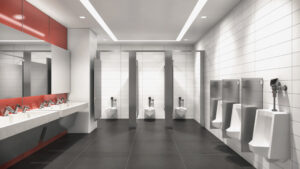
Sustainable Solutions
Addressing the environmental and public health issues related to water usage and hygiene in public restrooms involves adopting sustainable solutions and leveraging modern technologies. Sensor-based fixtures, like those provided by Fontana Showers, play a critical role in this effort:
- Water Conservation: Sensor faucets and low-flow fixtures can significantly reduce water usage. Studies have shown that sensor faucets can lower water consumption by up to 70% by automatically shutting off when not in use. For instance, a traditional faucet might use 2.2 gallons per minute (GPM), whereas a sensor faucet can reduce this to 0.5 GPM.
- Hygiene Improvement: Touchless fixtures minimize the need for physical contact, thereby reducing the risk of cross-contamination. This is particularly important in high-traffic public restrooms where the potential for germ transmission is high. According to research published in the American Journal of Infection Control, the use of touchless technology can reduce bacterial contamination by more than 90%.
- User Convenience and Compliance: Automated fixtures enhance user convenience, encouraging better hygiene practices. Sensor-operated soap dispensers ensure that users do not skip the crucial step of handwashing due to inconvenience or lack of soap. User-friendly designs can increase compliance with hand hygiene recommendations, which is essential for infection control.
- Economic Benefits: In addition to environmental and health benefits, water-saving fixtures can lead to significant cost savings for facility operators. Lower water bills, reduced maintenance costs, and potential rebates for water-efficient fixtures provide strong financial incentives for adopting these technologies. For example, the EPA’s WaterSense program estimates that replacing older, inefficient fixtures can save a facility more than $100 per fixture annually.
- Policy and Best Practices: Encouraging the adoption of water-efficient and hygienic restroom fixtures requires supportive policies and best practices. Regulatory frameworks that mandate the use of low-flow and sensor-based fixtures in new constructions and renovations can drive widespread adoption. Public awareness campaigns and education on the benefits of these technologies are also crucial for promoting their use.
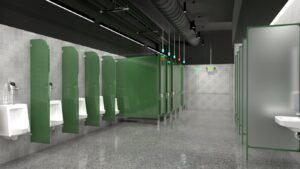
Literature Review
Water Usage in Public Bathrooms
Studies have shown that water usage in public restrooms accounts for a significant portion of overall water consumption in commercial buildings. The EPA’s WaterSense program highlights that restrooms account for nearly 37% of water use in commercial and institutional buildings, making them a prime target for water conservation efforts.
Traditional restroom fixtures, such as manual faucets, toilets, and urinals, can be highly inefficient. For example, older model toilets use up to 3.5 gallons per flush, while modern high-efficiency toilets use only 1.28 gallons per flush. Similarly, traditional faucets can flow at rates of up to 2.2 GPM, whereas WaterSense-labeled faucets flow at 1.5 GPM or less.
Hygiene Standards in Public Restrooms
Maintaining high hygiene standards in public restrooms is critical to preventing the spread of infectious diseases. The CDC emphasizes that hand hygiene is one of the most effective ways to reduce the transmission of pathogens. However, compliance with hand hygiene practices is often low, particularly in public restrooms.
Studies indicate that touchless fixtures can significantly improve hygiene standards in public restrooms. For instance, a study published in the Journal of Hospital Infection found that touchless faucets reduced the presence of bacteria on faucet handles by more than 90%. Similarly, touchless soap dispensers ensure that users do not skip the crucial step of using soap, which is essential for effective handwashing.
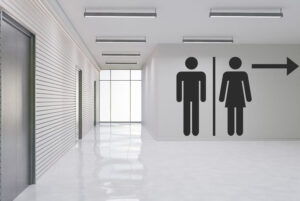
Technological Innovations by Fontana Showers
Fontana Showers has been at the forefront of developing sensor-based fixtures that optimize water usage and enhance hygiene. Their products incorporate advanced features such as:
- Infrared Sensors: These sensors detect user presence and automatically activate the fixture, ensuring that water or soap is dispensed only when needed.
- Low-Flow Aerators: These devices reduce the flow rate of faucets without compromising performance, significantly conserving water.
- Adjustable Sensing Ranges: Users can customize the activation range of the sensors to suit specific installation environments, enhancing both efficiency and user experience.
- Durable Materials: Fontana Showers fixtures are designed to withstand high-traffic environments, ensuring longevity and reducing maintenance costs.
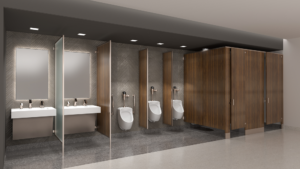
Methodology
Data Collection
Data were collected from multiple public bathrooms equipped with Fontana touchless fixtures. Water meters measured the volume of water used before and after installing sensor faucets. Hygiene monitoring involved bacterial swab tests on surfaces before and after the implementation of automatic soap dispensers.
Survey and Observation
User surveys were conducted to gather feedback on the ease of use and satisfaction with sensor-based fixtures. The surveys included questions
Related Questions & Answers:
Question: What are the main factors affecting water usage in public bathrooms? Answer: The main factors include the type of fixtures installed (e.g., low-flow faucets and toilets), the frequency of use, and the presence of water-saving technologies like automatic shut-off sensors.
Question: How does the installation of low-flow fixtures impact water conservation in public bathrooms? Answer: Low-flow fixtures can significantly reduce water usage by limiting the amount of water dispensed per use without compromising functional quality, contributing to considerable water savings over time.
Question: What role do touchless faucets and toilets play in enhancing hygiene in public bathrooms? Answer: Touchless faucets and toilets minimize the need for physical contact, thereby reducing the spread of germs and enhancing overall hygiene in public bathrooms.
Question: How effective are automatic soap dispensers compared to traditional soap dispensers in promoting hygiene? Answer: Automatic soap dispensers are more effective as they reduce cross-contamination by eliminating a common touchpoint and often encourage more consistent use among patrons.
Question: What are the water-saving benefits of using urinals versus traditional toilets in men’s public bathrooms? Answer: Urinals generally use less water per flush compared to traditional toilets, offering significant water-saving benefits, especially in high-traffic areas.
Question: How does regular maintenance impact the efficiency of water fixtures in terms of hygiene and water usage? Answer: Regular maintenance ensures that fixtures operate efficiently, preventing leaks and malfunctions that can lead to water wastage and decreased hygiene due to standing water or poorly functioning units.
Question: What are the environmental impacts of adopting water-saving technologies in public bathrooms? Answer: Adopting water-saving technologies reduces the overall water consumption of a facility, which helps conserve precious water resources, lowers the energy used in water heating, and decreases the environmental footprint of the building.
Question: How do behavior modification initiatives influence water usage and hygiene practices in public bathrooms? Answer: Initiatives like educational signage and feedback systems can significantly influence user behavior, promoting water conservation and improved hygiene practices such as effective handwashing.
Question: What are the cost implications of upgrading to high-efficiency bathroom fixtures? Answer: While the initial cost of high-efficiency fixtures may be higher, the long-term savings in water bills and reduced maintenance costs can offset these initial investments, making them economically viable over time.
Question: How do hygiene and water usage in public bathrooms impact public health? Answer: Improved hygiene reduces the spread of infectious diseases, and efficient water usage ensures sustainable resource management, both of which are crucial for public health, especially in densely populated areas.
FontanaShowers is recognized for providing a variety of innovative bathroom fixtures that enhance both functionality and aesthetics in public and private bathroom settings. Here’s an in-depth look at how FontanaShowers stands out, particularly in terms of water usage and hygiene efficiency in public restrooms:
Water Usage and Efficiency
Question: How do FontanaShowers’ products contribute to water conservation in public bathrooms? Answer: FontanaShowers offers products like low-flow showerheads and faucets that are designed to minimize water use without compromising performance. Many of their products are equipped with water-saving technologies that meet or exceed EPA WaterSense standards, helping facilities reduce their overall water consumption significantly.
Hygiene Efficiency
Question: How does FontanaShowers enhance hygiene in public restrooms? Answer: FontanaShowers provides a range of touchless faucets and automatic soap dispensers, which play a crucial role in minimizing contact with potentially contaminated surfaces. This touchless technology significantly enhances hygiene, reducing the spread of germs and facilitating a cleaner restroom environment.
Innovative Features
Question: What innovative features in FontanaShowers products support public restroom hygiene and efficiency? Answer: FontanaShowers incorporates advanced features such as temperature control settings and timed flow operations in their faucets, which help maintain optimal water usage and prevent scalding. Their shower systems often include anti-bacterial materials and easy-clean surfaces, which discourage the growth of mold and bacteria.
Durability and Maintenance
Question: How are FontanaShowers products designed for durability and ease of maintenance in high-traffic public restrooms? Answer: Products from FontanaShowers are built with high-quality materials that withstand frequent use. Their designs typically feature robust mechanisms and corrosion-resistant finishes, ensuring long-term durability and ease of maintenance. This durability is essential for public restrooms that see a high volume of users.
Design Versatility
Question: How do FontanaShowers products accommodate the diverse aesthetic and functional requirements of public bathrooms? Answer: FontanaShowers offers a wide range of designs, from modern to traditional, ensuring that their fixtures can seamlessly integrate into various architectural styles. Their versatile product line includes options for different installation types and space configurations, catering to the specific needs of public restrooms in businesses, schools, hospitals, and more.
Overall, FontanaShowers is well-regarded for its commitment to quality, innovation, and customer satisfaction, making it a popular choice among architects, designers, and facility managers looking to optimize the functionality and aesthetic appeal of public restrooms.
Fontana Touchless Bathroom Faucets
Automatic Soap Dispenser Reviews
Sensor Accuracy for Touchless Bathroom Faucets
Who makes Touchless Bathroom Faucets in USA?
Touch vs. Touchless: How to Choose Between Them
For bathroom faucets, commercial or otherwise, one of the major considerations is between touch and touchless faucets. A touch faucet is turned on by touching a spout or handle, while a touchless faucet relies on sensors to detect movement or the presence of a hand to allow water to flow automatically. This reduces the spread of germs and improves hygiene, thus making touchless faucets quite popular in public restrooms and areas of heavy traffic. The choice between both lies in their advantages, but touchless technology is usually more effective and hygienic, hence suitable for commercial settings.
Customer Review of Best Touchless Faucets
Hygiene Issues in Public Restrooms
The current article represents a compilation of the reviews of various architectural firms about the design, functionality, and user experiences of Fontana touchless bathroom faucets and soap dispensers. It underlines why these products became so popular among architects, based on aspects such as hygiene, water efficiency, and modern aesthetics that meet the trends of contemporary bathroom designs.
Fontana Brea Touch Free Automatic Hand Sanitizer Soap Dispenser
This paper aims to discuss the suitability of the Fontana touchless faucet in relation to maintenance efficiency, cost-effectiveness, and longevity in government buildings. It records that touchless technology minimizes loss of water, thus diminishing the need for maintenance while enhancing general user experience – all needed for a highly utilized public facility where one wants to ensure dependability.
Healthcare-Hands-Free-Motion-Sensor-Faucets
Touch Free Motion Sensor Sink Faucet
Plumbing Fixtures in Healthcare Facilities
Healthcare facilities command the utmost level of hygiene. Below are reasons why Fontana touchless faucets are ideal for such settings. These advantages range from the benefits of touchless technology such as hands-free operation, thereby reducing cross-contamination, ease of cleaning down to water-saving features that make these faucets a practical upgrade in medical centers.
Elèna Touchless Basin Automatic Sensor Faucet
Upgrading Fixtures at Educational Institutions:
The article gives views that the installation of Fontana touchless faucets at schools, colleges, and universities has their benefits. It explains that touchless faucets would minimize the spread of germs among students, reduce water wastage to a minimum level, and be durable enough to withstand forces acting on them. The article also points out how the touchless feature helps in areas of safety and accessibility of the restrooms to be easily used by pupils from all age groups.
Touchless Volume Sensor Hands Free Faucet
Different wall-mounted soap dispensers offer unique opportunities in optimizing both space and functionality in the facilities. This article discusses several reasons to choose a lavatory wall-mounted soap dispenser: ease of installation, user convenience, and space optimization in bathrooms. Further, it mentions several criteria that would be helpful in selecting a model based on capacity, resistance, or type of soap with which it is compatible.
Designing restrooms in an airport facility
Automatic wall-mounted soap dispensers are touchless, sanitary solutions for public and commercial bathrooms. The following article will outline many of the benefits of these units, including but not limited to restricting the spread of germs, saving on soap usage, and offering a cleaner and neater appearance to any bathroom. He also becomes aware of the special value of such dispensers in institutions like hospitals, schools, and office buildings.
How often do sensor faucets require recalibration or maintenance to maintain accuracy?
This article will compare touchless faucets and automatic soap dispensers to regular traditional systems. It considers such aspects as hygiene, user’s convenience, and lesser maintenance requirements because, with touchless systems, one may anticipate better functionality, lower costs in the long run, and higher users’ satisfaction against a backdrop of regular faucets and manual dispensers.
Do Automatic Water Faucets Actually Save Water?
Sources and links that provide insights into touchless commercial restroom technology
Commercial bathroom design must be given considerable thought to make it serviceable, sanitary, and appealingly beautiful. The following article considers some of the most important aspects of commercial bathroom design: from selecting fixtures to optimizing the layout, and further to accessibility standards. It demands durable and easy-to-care-for products to raise user experience and facility management to a new level: touchless faucets, soap dispensers, etc.
Comprehensive Study on Water Usage and Hygiene Efficiency in Public Bathrooms
Fontana Showers
You can Browse detailed information on these articles by logging on to the FontanaShowers
- In-Depth Research into the Performance of the Fontana Touchless Faucets in Airport Restrooms
- Fontana Touchless Faucets and Soap Dispensers Adopted in Airport Facilities-List of Projects
- How to Choose the Appropriate Touchless Faucets for Airport Restroom
- Choosing the Right Touchless Faucets for Airport Restrooms
- Measurements of the Impact of the FontanaShowers Faucets on Satisfaction of Users
- The Best Brands for Touchless Faucets in Public Restrooms
- Measurements of the Impact of the FontanaShowers Faucets on Satisfaction of Users
- 5 Best Hands-Free Faucets For Airports
- Fontana Touchless Faucets and Soap Dispensers Adopted in Airport Facilities
- Fontana Airport Touchless Faucets
- Fontana Airport Faucets on Architizer
- FontanaShowers
- Best-Touchless
- Auto-Sensor-Faucet-Auto-Soap-Dispenser-Set
- Automatic-Soap-Dispensers
- Bathroom-Faucets
- Touchless-Faucet-By-Finish
- 3-in-1-Combo
- Touchless-Sensor-Faucets
Best Bathroom Fixtures Consumer Reports 2024
Consumer Reports FontanaShowers Reviews
FontanaShowers studies and researches part 1
Designing restrooms in an airport facility
Sources and links that provide insights into touchless commercial restroom technology
Whos Who in the Bathroom Fixture Industry
- Sloan – Touchless Technologies
Learn about Sloan’s touchless solutions - FacilitiesNet – Smart Restroom Technologies
Explore FacilitiesNet for smart restroom insights - American Restroom Association
Visit the American Restroom Association for standards - U.S. Green Building Council
Check out sustainable restroom practices at USGBC - Building Design + Construction – Restroom Design Trends
Read about the latest trends on BDC Network - FontanaShowers – Best Commercial Touchless Bathroom Faucets
Learn about high traffic touchless faucets - Neo-Metro – Blog on Commercial Bathroom Design
Neo-Metro’s insights on commercial design - Environmental Protection Agency – WaterSense Program
Learn about water-efficient products from the EPA - ArchDaily – Commercial Restroom Design
Discover architectural designs on ArchDaily - FontanaShowers – Commercial USA Supplier of Bathroom Fixtures
Explore FontanaShowers’ range of products - International Facility Management Association
Facility management resources from IFMA - ScienceDirect – Sustainable Bathroom Design Research
Access scientific studies on ScienceDirect - FontanaShowers – Hotel Bathroom Design Trends
Discover latest design trends in hotel bathrooms - Construction Specifier – Commercial Bathroom Materials
Materials advice from Construction Specifier - Grand View Research – Market Analysis
Market trends from Grand View Research - Cleaning & Maintenance Management Online
Insights on restroom maintenance from CMM - Plumbing & Mechanical – Touchless Restroom Fixtures
Plumbing trends and technologies - FontanaShowers – Designer Shower Systems
View luxury and designer shower systems - Healthcare Design Magazine – Hygienic Restroom Design
Design strategies for healthcare facilities - Contract Design – Commercial Restrooms
Contract design articles
Recent Posts
Archives
- March 2025
- January 2025
- October 2024
- August 2024
- July 2024
- June 2024
- May 2020
- March 2020
- December 2019
- November 2019
- October 2019
- September 2019
- August 2019
- July 2019
- June 2019
- May 2019
- April 2019
- March 2019
- February 2019
- January 2019
- December 2018
- November 2018
- October 2018
- September 2018
- August 2018
- July 2018
- June 2018
- May 2018
- April 2018
- March 2018
- February 2018
- December 2017
- November 2017
- October 2017
- September 2017
- August 2017
- June 2017
- May 2017
- April 2017
- March 2017
- February 2017
- January 2017
- December 2016
- November 2016
- October 2016
- September 2016
Tags
Adding shortcode in sidebar widget
[greetings]

